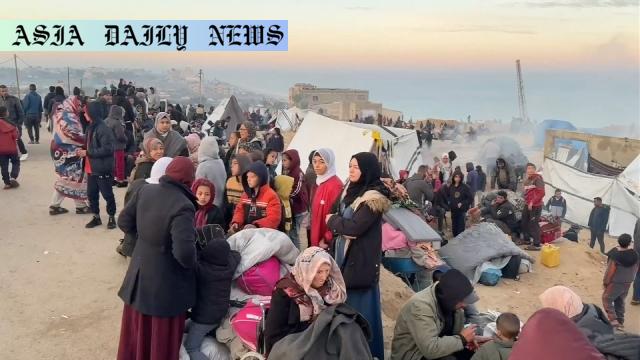Hostages: Hamas declares the release of multiple hostages, prompting ease in movement restrictions for displaced Gazans.
Hamas announces plans to release six hostages this week.
Israel lifts movement restrictions for displaced Gazans.
Ceasefire agreement sees reciprocal actions from both parties.
Residents in Gaza begin returning to northern areas amid ceasefire.

Introduction
The longstanding and escalating conflict between Israel and Hamas has entered a temporary period of relative calm with the announcement of a six-week ceasefire and mutual actions taken by both parties. Hamas has committed to releasing six hostages throughout this week. In turn, Israel has responded by lifting movement restrictions for Palestinians, particularly those displaced in the Gaza Strip. This recent development is a potential sign of easing tensions and an effort toward humanitarian resolutions amidst the challenges of conflict.
Hamas’s Recent Actions and Promises
As part of its broader commitment to the ceasefire agreement that came into effect on January 19, Hamas publicly stated plans to release six hostages over a span of several days. The announcement included details of releasing one female civilian and two others within the week. This follows their previous release of seven female hostages, demonstrating some willingness to cooperate in reducing human suffering caused during this prolonged tension. However, it should be noted that the motivations for these releases likely include political and strategic calculus.
Israel’s Response to Hostage Releases
In response to the hostages’ release by Hamas, Israel took a significant step by lifting its movement restrictions for displaced Palestinians in southern Gaza. Many of these individuals had earlier fled from northern Gaza when the violence initially unfolded. By allowing access to return to their homes in the north, Israel appears to be reciprocating the goodwill gestures amid the ceasefire. However, questions remain about the sustainability of these humanitarian actions within a region marred by decades of distrust and intermittent escalations.
The Humanitarian Aspect: Challenges and Hopes
For the displaced residents of Gaza, this lifting of movement restrictions is an opportunity to begin the long process of resettling, rebuilding, and, hopefully, creating a sense of normalcy after months of upheaval. Footage from the central region of Nuseirat captured many Palestinians returning to the northern areas of Gaza early Monday morning. This movement highlights the urgent need for humanitarian relief and reconstruction in areas scarred by conflict. Yet, how long this fragile calm can be maintained remains uncertain.
Historical Context of the Conflict
To understand the weight of these recent events, it is essential to consider the broader context of the Israel-Hamas conflict. Over decades, this conflict has resulted in widespread destruction, loss of countless lives, and socio-political turmoil on both sides. The hostilities resumed in October 2023, further displacing thousands of Gazans and deepening the humanitarian crisis in the already beleaguered enclave. Ceasefires and prisoner exchanges have been part of previous cycles of escalation and temporary calm, often representing brief reprieves rather than long-lasting solutions.
The Ceasefire’s Implications for Peace
The current six-week ceasefire offers an opportunity to reassess and attempt incremental progress toward peace. Both parties’ adherence to their commitments during this time may also pave the way for more extensive negotiations. Trust-building measures, including humanitarian gestures like the release of hostages and easing of restrictions, could serve as stepping stones for broader reconciliation efforts. However, significant political and territorial disputes remain unresolved, requiring immense political will and collective efforts to address.
International Reactions
The current developments have drawn attention from the international community, with various nations and organizations urging both sides to continue pursuing humanitarian actions. Calls for lasting peace and mutual respect resonate as regional and global stakeholders remain invested in the Middle East’s stability. Continued monitoring and diplomatic involvement will be necessary to maintain the momentum toward resolving this deeply entrenched conflict.
Conclusion
While the recent moves by both Hamas and Israel signify cautious progress, the conflict’s deeply rooted complexities call for sustained dialogue and action. The hostages’ release, the lifting of movement restrictions, and the ceasefire are steps in a constructive direction. Yet, these efforts will need robust, long-term support and political commitment to ensure they are more than fleeting moments of calm amidst turbulence. The international community’s role in promoting stability and supporting humanitarian measures remains critical in this endeavor.



Commentary
Significance of the Hostages’ Release
The planned release of hostages by Hamas stands as a significant step in the ongoing tension between Hamas and Israel. While this action may stem from a mix of humanitarian and strategic reasons, it undoubtedly brings momentary relief to the families affected by this prolonged and painful humanitarian crisis. Such gestures, while not completely new, always reignite hope that a pathway to peaceful coexistence might still be achievable despite the deep divides.
Israel’s Lifting of Restrictions: A Humanitarian Gesture
Israel’s decision to lift movement restrictions for displaced Palestinians is commendable, particularly given the ongoing challenges faced by those affected by displacement in Gaza. The prospect of families returning home symbolizes a tenuous but much-needed ray of hope for a geographically and emotionally fractured population. While such measures are rare and often tactical, their positive impact on ordinary civilians cannot be underestimated.
Broader Implications and the Way Forward
These developments, when viewed in a broader context, reveal just how fragile yet vital gestures of goodwill are in conflicts of this nature. Although symbolic actions like hostages’ release and movement easements do not resolve the root causes, they are necessary steps that keep alive the possibility of dialogue and long-term resolution. They serve as crucial reminders to all stakeholders – both local and international – of the human cost of this endemic conflict.
Final Thoughts
As we observe these momentary breakthroughs, it is essential to sustain pressure on both Hamas and Israel to avoid future escalation and prioritize humanitarian needs. Peace is a complex and arduous process, often requiring patience, compromise, and resilience. Despite the challenges, developments like these hint at the possibility of breakthroughs, even in one of the world’s most intractable conflicts.